This is the Trumpeter 01587 kit in 1/35 scale, of the ‘Krupp/Ardelt Waffentrager 88mm PaK 43’.

This is the Trumpeter 01587 kit in 1/35 scale, of the ‘Krupp/Ardelt Waffentrager 88mm PaK 43’.

This is the Trumpeter 00389 kit in 1/35 scale, of the ‘German Bergepanzer IV, Recovery Vehicle’.
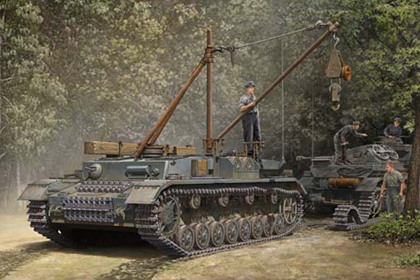
Bergepanzer IV : A recovery vehicle, essentially a turretless Panzer IV chassis fitted with a crane. In May 1944 Bergepanzer 36 stared being built.
This is the Trumpeter 05553 kit in 1/35 scale, of the ‘KV-220 Super Heavy Tank’.
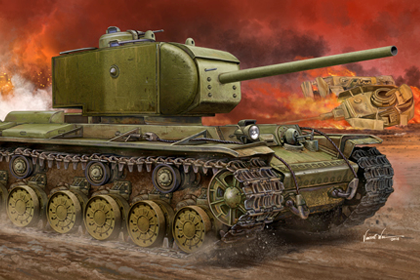
New diamond-shaped turret. 85mm F-30 cannon. One prototype was constructed in 1941. The tank was lost in battle.
The KV-220-2 had its turret removed (The turret and KV-220-2 were both used in the defense of Leningrad) it was fitted with a KV-1 turret and F-32 cannon. The tank was lost in battle, supposedly later repaired, and sent to a training unit.
This is the Trumpeter 09542 kit in 1/35 scale, of the ‘German Super Heavy StuG E-100’.

Work on E-tanks was abandoned before the end of WWII.
This is the Trumpeter 05575 kit in 1/35 scale, of the ‘Russian Project 704 SPH’.

The self-propelled gun carried 20 rounds of two piece (shell and charge) armor-piercing and high explosive ammunition. The secondary armament of the fighting vehicle consisted of two 12.7 x 108mm DShK machine guns, one anti-aircraft and one co-axial.
This is the Trumpeter 09503 kit in 1/35 scale, of the ‘Russian KV-7 Mod. 1941’.
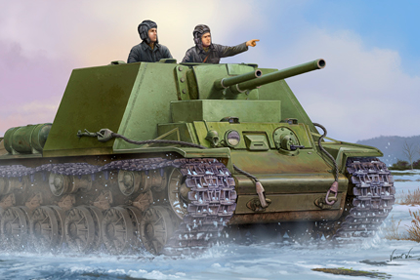
The KV series were known for their heavy armour protection during the early part of the war, especially during the first year of the German invasion of the Soviet Union. In certain situations, even a single KV-1 or KV-2 supported by infantry was capable of halting the enemy’s onslaught.
German tanks at that time were rarely used in KV encounters as their armament was too poor to deal with the “Russischer Koloss” – “Russian Colossus”.
This is the Trumpeter 05589 kit in 1/35 scale, of the ‘Russian JS-2M Heavy Tank (Early production)’.
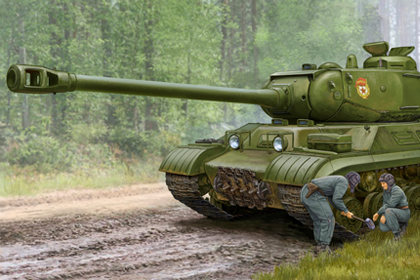
The heavy tank was designed with thick armour to counter the German 88mm guns, and sported a main gun that was capable of defeating the German Tiger and Panther tanks. It was mainly a breakthrough tank, firing a heavy high-explosive shell that was useful against entrenchments and bunkers.
The IS-2 was put into service in April 1944, and was used as a spearhead in the Battle for Berlin by the Red Army in the final stage of the war.
This is the Trumpeter 05547 kit in 1/35 scale, of the ‘Russian T-10A Heavy Tank’.

The biggest differences from its direct ancestor, the IS-3, were a longer hull, seven pairs of road wheels instead of six, a larger turret mounting a new gun with fume extractor, an improved diesel engine, and increased armour. General performance was similar, although the T-10 could carry more ammunition.
T-10s (like the IS tanks they replaced) were deployed in independent tank regiments belonging to armies, and independent tank battalions belonging to divisions. These independent tank units could be attached to mechanized units, to support infantry operations and perform breakthroughs.
This is the Trumpeter 05588 kit in 1/35 scale, of the ‘Russian JS-2 Heavy Tank’.
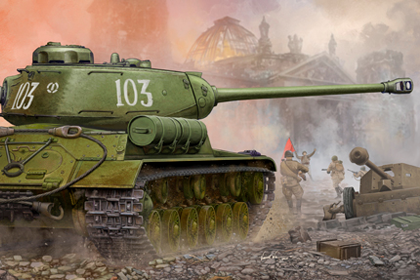
The heavy tank was designed with thick armour to counter the German 88mm guns, and sported a main gun that was capable of defeating the German Tiger and Panther tanks. It was mainly a breakthrough tank, firing a heavy high-explosive shell that was useful against entrenchments and bunkers.
The IS-2 was put into service in April 1944, and was used as a spearhead in the Battle for Berlin by the Red Army in the final stage of the war.
This is the Aber, Exclusive Edition photo etch sets for the ‘German Sd.Kfz.186 Panzerjäger (Jagdtiger)’ from Tamiya.
Detail set |
Tamiya |
||||
| (35 K07) | Exclusive edition | 35 295 | |||
Source: Aber
This is the Aber, photo etch sets for the ‘German Sd.Kfz.186 Panzerjäger (Jagdtiger)’ from Tamiya.
Detail set |
Tamiya |
||||
| (35 228) | Basic | 35 295 | |||
| (35 229) | Additional set, fenders | 35 295 | |||
| (35 A041) | Side skirts | ||||
| (35 G06) | Grilles | 35 295 | |||
| (35 G25) | Grilles | 35 295 | |||
| (35 L084) | PaK 44 L/55 128mm gun barrel | 35 295 | |||
Source: Aber
This is the Trumpeter 02325 kit in 1/35 scale, of the ‘Russian A-19 122mm Gun (1931/1937)’.

The gun was in production from 1939 until 1946. It saw action in World War II (primarily with corps and RVGK artillery of the Red Army) and remained in service for a long time after the end of the war.
Vehicle-mounted variants of the gun were fitted to the IS-2 and 3 tanks and ISU-122 self-propelled gun.